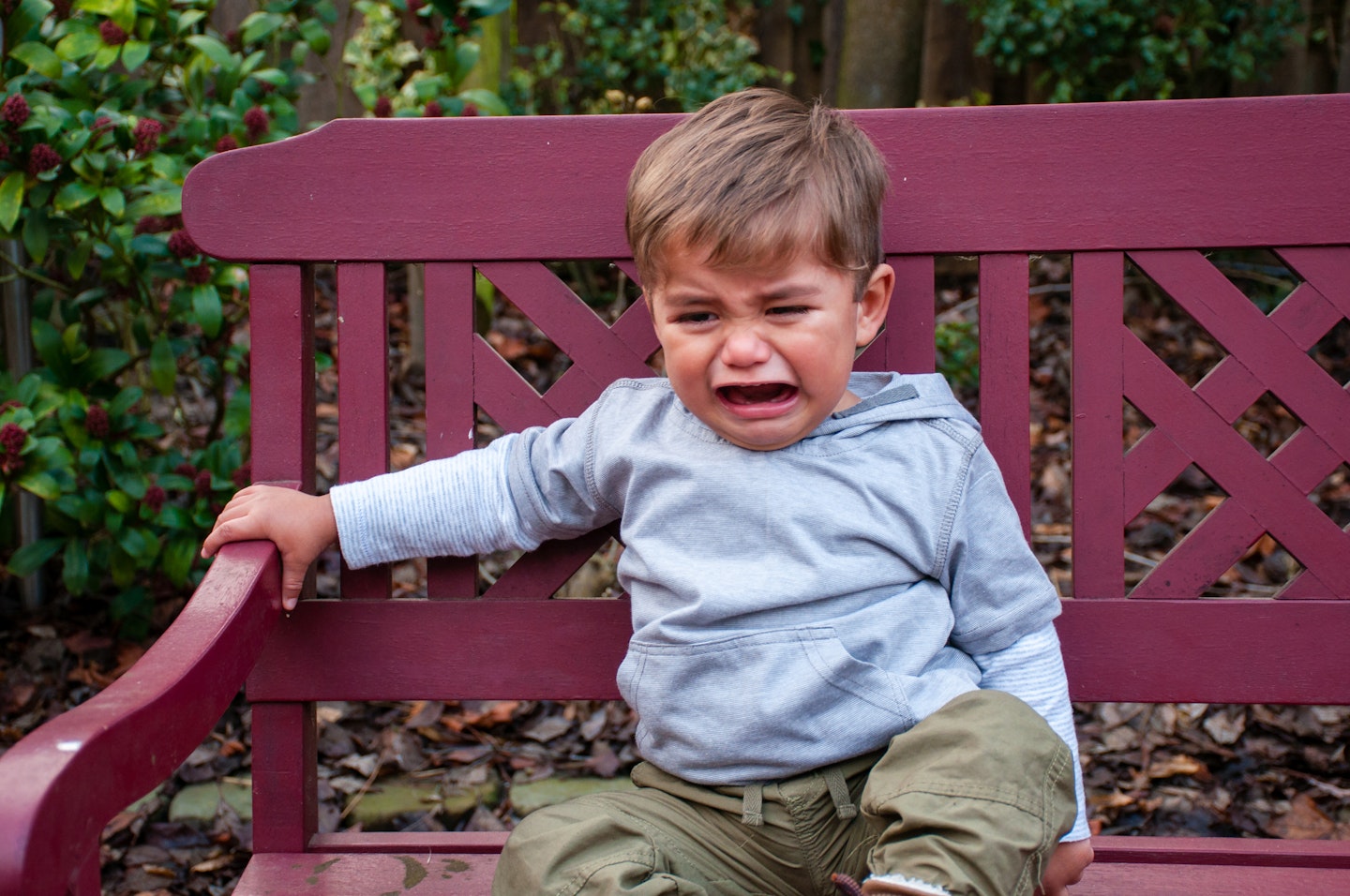These clever tricks will help to minimise the emotion, says psychologist Rebecca Shrag Hershberg…
If in the past day or two, you’ve stood in front of a shrieking, stomping little human, you’ll know firsthand that you can feel so many other emotions when your child explodes at being served the wrong type of banana – frustration, shame, powerlessness, anger, regret, guilt, rage, sadness, hopelessness… I get it. I am a parent of two little boys aged 21 months apart, and when I get together with my mum friends, at least one usually wants to vent about her child’s latest breaking-all-the-records tantrum. And yet, even though we all use the same word, ‘tantrum’, we don’t always mean the same thing by it.
In this article we will explore:
-
What is a tantrum?
-
What causes tantrums?
-
Main contributors
-
How to manage a tantrum
What is a tantrum?

Picture a little boy screaming on the supermarket floor – he’s having a tantrum, right? But what about the little girl whose disappointed tears over her scoop of ice cream falling off its cone morph into inconsolable wailing? We might call this a tantrum if we only saw the behaviour in question, but then perhaps backtrack once we discovered the origins.
My point is, the behaviour we call a ‘tantrum’ doesn’t happen in isolation – we need to consider the conditions and events that lead up to the tantrum; the problem your toddler may have been attempting to solve; your response; and all of the emotions involved for both you and your tot. More often than not, your child may feel frustrated, disappointed, sad, afraid, and/or overwhelmed.So, my definition of a tantrum is that it’s a behavioural response to not knowing how to manage or express an overwhelming emotional experience. And in young children, that’s completely normal and natural.
What causes them?

I’ve had parents ask me, sincerely, if I am absolutely certain that their toddler is not a psychopath. They’re concerned there really is something wrong. But young brains are wired in such a way that tantrums make perfect sense, and are actually a sign of healthy development. Brains are built from the bottom up, with simpler pathways – hearing and vision, for example – developing first, followed by those of increasing complexity. The ability to have a tantrum necessitates neural circuitry that is quite complex, for children to be able to perceive the world around them, regulate their emotions, communicate and use language, problem-solve, exercise judgment and make decisions. And these abilities exist in several areas of the brain that undergo a period of rapid development in the first few years of life.
Our expectations for toddlers’ capacity for self-control are typically far too high: a study found 42 per cent of parents believe that children can regulate their emotions by age two. In reality, this capacity only begins to develop when children are between three and a half and four years old, and it takes several more years for to master it. We often don’t recognize that our toddlers are working so hard, in an ongoing and nearly constant way, to have a tantrum, and that this task alone takes an extraordinary level of energy, effort, and skill. Which is one reason that tantrums increase, in both frequency and severity, when toddlers are tired or hungry. In those moments – they just don’t have the reserves required to expend energy on keeping it together.
What’s contributing?

Think of your child’s most recent tantrum and then consider the following points. They’ll help you realise that there might have been more going on than you first thought.
-
How was my child feeling before the tantrum? (Tired, hungry, sick, already frustrated, sad?)
-
How did he sleep last night?
-
Have there been any big changes in his world in recent days or weeks?
-
How did the day go overall? (Smoothly, with lots of little hassles, or nothing went right?)
-
How were my mood and stress level today?
-
How were my toddler and I getting along today?
-
Were we interacting with anyone else prior to the tantrum? How might this person (or persons) have contributed somehow?
-
How was I feeling right before the tantrum?
-
Did I have any expectations about how I wanted my child to behave that may have been unrealistic?
-
What happened right before the tantrum?
Once you can start to spot all the links in the chain that might be leading to a tantrum, you can then take action before you get to the crunch point! Each link in the chain offers an opportunity to head off or intervene in a tantrum, and now you have lots of ways to do that!
8 ways to to head off a tantrum
 1 of 8
1 of 81) Be silly!
Tantrum simmering? When toddlers are building to the exploding point, surprise can be your friend – so be prepared to try something you’ve never done before!
Toddlers love silly, especially when it comes from Mum bursting into off-key song in the middle of the supermarket, or challenging them to a jumping race out of the playground when it’s time to leave. You might not feel comfortable at first but, trust me, this tantrum de-escalation strategy is worth looking silly for!
 2 of 8
2 of 82) Think ahead
Seeing the world through your child’s eyes really helps. I recently left some dried mango that I’d bought as a treat for my son Henry on the kitchen counter. Henry came into the kitchen to have dinner, at which point his eyes landed on the mango with a laser-like focus. ‘I want mango!’ he demanded. And, just like that, I had an impending tantrum to derail.
Had I remembered that, at Henry’s height, the counter is exactly at eye level, I’d have put the dried mango in the cupboard. Henry wouldn’t have seen it, asked for it, been told he couldn’t have it, and started to lose his mind. It’s like falling dominoes: you have the power to place the first domino where it won’t knock down any others if it falls.
 3 of 8
3 of 83) Name the emotion
When toddlers have a tantrum because they can’t manage their emotional distress, it often starts with not even knowing what emotion they are experiencing. And learning names for feelings can help.
So, if your child is upset that she can’t have a biscuit, simply acknowledge her desire and frustration by describing what’s going on: ‘I know, sweetie. I see how upset you are. You’re feeling frustrated and disappointed that you can’t have a biscuit right now, huh? You really, really want that biscuit.’
 4 of 8
4 of 84) Regulate your emotions
What do you look like when you’re angry or upset? Do you curse like a sailor when someone cuts you up on the road or slam your bedroom door when you feel disappointed or let down?
How your child learns to handle her difficult feelings is going to depend a great deal on how she sees you handling yours. If you start to take three deep breaths when you feel frustrated, and to say out loud that this is what you’re doing, your child may learn to do that too.
 5 of 8
5 of 85) Give good attention
More than anything else in the world, toddlers want their parents’ attention. So, it follows that whatever gets the most attention are the behaviours they’ll repeat.
Take when you go out and ask your child to put on his jacket. If he does it without protest, you may say ‘Good job’. If he refuses to put it on, he’ll gain several extra minutes of time with you, during which your attention is solely on him. In toddler world, this is called hitting the jackpot.
So, give more attention to a behaviour you want to promote than to a behaviour you want to eliminate. When you see the beginning of a tantrum, pull out your phone and scroll, guilt-free.
Sometimes if you ignore the behaviours that signal an oncoming tantrum, your toddler will get the message and cease and desist.
 6 of 8
6 of 86) Skip the explanation
Too often, when toddlers are on the verge of tantrums, we intervene with logical, rational explanations intended to decrease frustration. This can make things worse. Your toddler’s initial frustration becomes compounded because he feels neither heard nor understood.
Instead, reflect back how your child is feeling so that you connect and communicate that you get it and that you’re on the same team.
 7 of 8
7 of 87) Distract with a question
When trouble’s brewing, ask a question that seems to come out of the blue. One of my favourites is, ‘Hey, do you remember what you had for breakfast this morning?’ Most kids won’t recall this right away, and their subsequent pause will serve the dual purpose of taking their mind off their distress and buying you time to think about where you’re going to take the conversation.
Then it’s just about thinking on your feet: say she says she had scrambled eggs, you could tell her about how eggs come from chickens, ask what colour scrambled eggs are and what other things in the room are yellow, make up a song about eggs, ask whether the Gruffalo likes eggs…
 8 of 8
8 of 88) Choose your battle
Toddlers have almost no autonomy: they’re told what, when and where to eat; when and where to sleep; what to wear; how to spend their days, and who to spend them with. This occurs at the same time developmentally they’re craving independence and control. Problem? Yep! Giving your toddler simple choices helps to reduce the tantrums that little dilemma creates.
Avoid an open choice such as ‘What do you want for breakfast?’ which can pave the way for a power struggle when she requests cake, and instead give her straightforward choices such as does she want her eggs on a plate or in a bowl.
